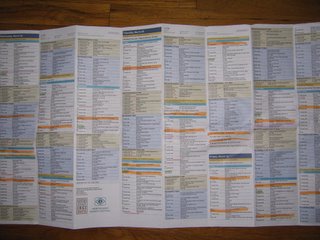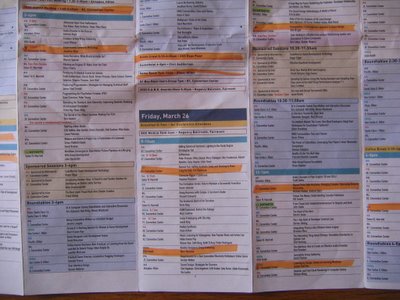Note: This is part of a series of articles called Effective Networking in the Games Industry. I’m writing these articles in no particular order, so I’m sorry if this seems scattered. I promise I will collect it all and put it on my permanent webspace for future reference.
Your Program Guide
When you step into the SJCC, the first thing you’re going to have to do is register for your pass. You might have already received your pass in the mail, but you still have to register and get your books, fliers, and, most importantly, your program guide. I say without hesitation that your program guide is the most important tool you have (other than your wit and disarmingly good looks) in your quest to make the most out of GDC.
The program guide is compact, and it folds out like a map. In fact, it actually contains a map of the convention center, with all the rooms conveniently labeled. But the most important thing is the actual program guide: the list of what lectures are happening, when. Here’s a picture I took of my guide from GDC 2004.

You’ll notice that the program guide is incredibly information dense, a very good thing for a Tufte-head like me. Let’s zoom in a little bit to get a handle on things.

The guide lists the session title, the presenters, the room number, and the presentation track (design, audio, visual art, production, business, etc.). Everything is grouped by day and time slot.
You’ll also notice some sessions in orange. Those sessions were not orange until I got my hands on them. Remember how I mentioned in Part 1 the benefits of getting to the conference very early? One of the things you should do is sit down with your program guide and highlight all the sessions you might be remotely interested in attending. It’s important to try and highlight more than one session per time slot. Some of the sessions get pretty crowded, so it’s nice to have an alternative if you find you can’t fit into the room. Also, some sessions, particularly roundtables, are repeated later.
The Types of Session
Which reminds me: I should mention that there are a few basic kinds of sessions. I’ll break them down for you.
- Lecture. This is the meat and potatoes of GDC. It’s one or two people, 45 minutes, imparting supreme wisdom to the audience. As long as the person is a good presenter and knows what they’re talking about, you can’t really go wrong. Networking opportunities: engage in conversation with those seated around you both before and after the session. They’re interested in the topic enough to attend a lecture, so you probably have some common ground.
- Roundtable. The roundtable is where there’s a moderated discussion between 10 to 30 participants. The moderator talks for about five minutes and then asks a question. The roundtable participants, including you, are invited to respond. There’s usually some healthy debate here. Networking opportunities: if you think you know enough about a topic to participate in meaningful conversation, then definitely go to at least one roundtable during the week. This is also the only place where you learn something, however miniscule, about the other people at your session. This means if one of the 30 people at the table mentions something that you have in common, you can approach them about it afterwards!
- Sponsored session. Ugh. Unless you’re at GDC to get swag, do yourself a favor and don’t go to these. They’re extended infomercials usually held by middleware or hardware companies. (Incidentally, if you’re at GDC to get swag, do me a favor and stay the hell away from my industry.) Networking opportunities: none. There is nobody at a sponsored session worth knowing.
- Panel. The panel discussion is often a mixed bag. If there are five brilliant people on the panel, it’s probably worth attending just to see them argue with each other. If you only care to see one of the five people, be aware that your favorite person is only going to be speaking for 9 minutes of the 45-minute session. Networking opportunities: see Lecture, above.
- Workshop. [Added per Craig's request.] There’s only one real workshop that I’m aware of at GDC. Some things are called workshops, but they’re little more than lectures. The real deal is the Game Tuning Workshop. This is a 2-day workshop which is part of the Monday/Tuesday tutorials that only 30% of GDC attendees buy passes for. The attendees are divided into groups of six to 10 people, and are tasked with a design challenge. For instance, the challenge might be to write a pitch for a video game based on a license, and your group is assigned a random license picked out of a hat. Networking opportunities: pretty amazing. You are literally working alongside industry professionals on game designs. I did some of my best networking last year at this workshop, and I found myself working with people who worked on some of my favorite games of all time.
But Wait, There’s More!
I’ll be posting at least one more article in my GDC Guide sub-series. Keep your eyes peeled, readers.
{ 1 comment }
You forgot labs! You know, like when they tell you to design a game using specific principals, or such.
Hell, that was the most fun I had last time. I didn’t get a whole lot of networking done, but I imagine someone thinking about it would find them extremely easy to network.
Comments on this entry are closed.